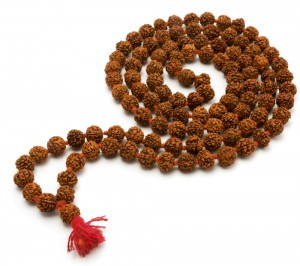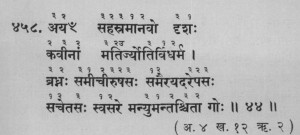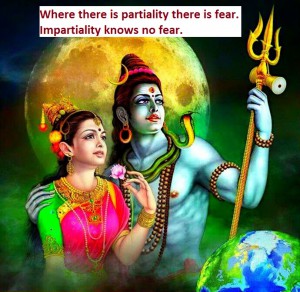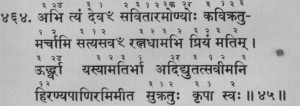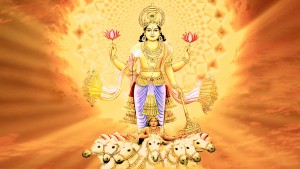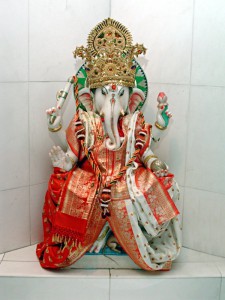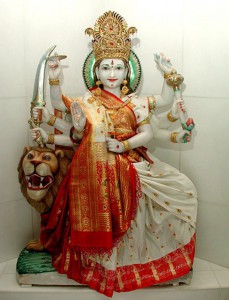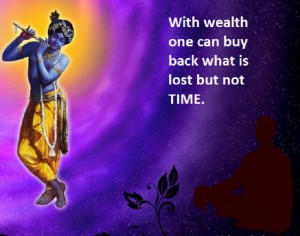VAAMAN SAMVED- RICHAS 41 to 50
RICHAS 41 to 50
VAAMAN SAMVED
Sam Ved ( Adhyaya 4—Khand 11—Richa 7 ).
DON’T LET THE SENSES STRAY!
Jeeva prays to the Lord—“Hey Sarveshwara!
You are the one who rules over everyone. Just as everything that you give away like a gift or charity goes to the rightful person who is worthy of it,
please bless our sense organs going outwards to the sensory impulses to go directly on the right path.
This way with your blessings may we become JITENDRIYA ( जितेन्द्रिय)—the one who has conquered the sense organs.
SAM VED (ADHYAYA 4—KHAND 11—RICHA 9).
PRAYERS FOR SPECIAL GRACE.
Hey Prabhu !–You who are in the form of Indra, Mitra and Varun— please bless us so that with your grace our Ida and Pingala nadis are
energized by the correct practice of pranayam .
(Ida and Pingala nadis are also called the Sun and Moon Svara/rhythm).
Please grant us the happiness achieved through Samadhi.
Also Hey Indra!
Along with Surya, Varun and other devtas please bestow unflinching bhakti which is regular and full of love for you and is of the Supreme kind.
Please also bless us with wealth –Laxmi.
SAM VED (ADHYAYA 4—KHAND 11—RICHA 10).
KNOWLEDGE AND DEVOTION BOTH ARE REQUIRED FOR A DEVOTEE.
Devotees! The Lord—‘Parameshwara’ spreads His effulgence all over the world. In fact He rules over the entire Universe.
Seek refuge of that Lord who is the ruler of the Brahmand.
It is known that those following Advait (non-pluralism) consider Moksha is possible only by knowledge. The Vaishnavs –those who believe in idol worship consider
Bhakti as the means of Moksha.
But the ones who follow the Vedic path consider the blend of both knowledge and devotion as the means of liberation or moksha.
In the Rig Ved the word used for the ones who have realized their true self is –( विपन्वाया ) VIPANVAYA. The meaning of this adjective is — ‘the devotee who sings the glories of the Lord’.
This clearly indicates that knowledge and devotion both are required for liberation.
For example the mango fruit has to be peeled so that the inner flesh can be visible and its juice procured.
Our eyes remove the veil on the different images and forms and thus we are able to see. The nose and its sense of smell reveals the different aromas and the tongue
makes us know the different kinds of tastes.
In the same way if we want to enjoy the happiness that is procured by Mukti we have to remove the many veils with which SAT CHIT ANANDA swaroop of the Parmatma is covered.
To know the SAT aspect of the Lord we need to have Paroksh Gyan (knowledge got with inference or direct testimony).
Vedic declarations like ( तत्त्वमसि )TAT TVAM ASI etc. are the means of removing the veil of ignorance with regard to the CHIT aspect of Brahman.
The last one –ANAND aspect is covered by Maya and it is necessary to transcend this Maya.
But this MAYA is an obedient wife of the Lord and she only obeys the commands of her Lord!
When her Lord asks her to remove the ‘veil of ignorance’ covering His ANAND aspect, only then does she move away.
It is only then that the devotee becomes a recipient of the Lord’s grace.
In the Geeta, Bhagwan Himself says—“Hey Arjun! As I am covered by Yogmaya, I am not visible to everyone.”
He also says that no one can know me without seeking refuge at my feet.
The MUMUKSHU, the one desiring Moksha seeks knowledge to remove his AVIDYA but if he wants to remove the veil of MAYA he must seek the grace of the
Lord by devotion and taking shelter at His feet.
SAM VED (ADHYAYA 4—KHAND 12—RICHA 2).
A QUEST FOR LIBERATION.
Jeeva says Hey Prabhu! When our esteemed Sad Gurudev, who has the right kind of vivek (discrimination) gives us the teachings of the Maha Vakyas of the Vedas,
you remove the sorrow that has engulfed us by showing your true form because you are so compassionate and benevolent.
Then with your benediction, I am full of zeal and am able to overcome all the hurdles that come in the way of my search for liberation, by bringing about the
modifications in my mind that help me to know my true self—I am able to have ‘Brahm Sakshaatkar’ ( ब्रह्म साक्षात्कार )
How can I describe your greatness!
You have many worshippers.
Mumukshus (those desirous of liberation) and Yogis both desire to have your darshan and consider that to be the goal of their life!
Amongst the genius and learned ones you are the most eulogized (praiseworthy).
In the intellectual ones you are their intellect!
You are the one who creates and then maintains this Samsara and you are the self-effulgent Parameshwara (Supreme Lord).
For the devotees you are ever ready to shower your blessings and you are the very root of the tree of creation
It is true that at the time of learning the Vedas the extreme sorrow in the heart of the devotee arises. He keeps repenting for wasting away this human life-
-being caught up in the throes of family, wife and children and neglecting the main goal of life.
He laments saying –“I did not attain what I should have. I have failed miserably.
I am a fool of the first order! This valuable human life of mine I have exchanged it with the worthless indulgences in life which are as useless and have no value whatsoever.
I wonder what will be my state after my death. I am sure Yamraj, the Lord of death will tighten his noose on my neck and with his instructions the representatives will take me to hell.
Oh my Lord!
I did not discriminate and apply the most fundamental value of life –VIVEK —which would have given me my freedom!”
SAM VED (ADHYAYA 4—KHAND 12—RICHA 8 ).
POOJA — OFFERINGS TO THE LORD.
The devotee says I perform the ritualistic and systematic pooja to the Lord with silver, gold and various valuable items along with the prescribed
Vedic injunctions because the Lord is the creator of this Earth and is famous and well known throughout the world.
I offer these prayers by my mind, by my speech and by my actions—MANSA, VACHA, KARMANA.
My Lord, to whom I offer my prayers can be addressed as an abode of many glories.
He is Trikaal darshi (त्रिकालदर्शी- one who knows the present ,past and future) and whatever He does it has a divine plan and is meticulously carried out.
He has created this illusionary world with all its diversities. He is the one who inspires us in life.
He is adorned with the pleasing and beautiful ornaments of diamonds and pearls.
In fact, He bestows these riches on His devotees.
He is loved and praised by all.
His effulgent energy called the Para Shakti is the fundamental material substance out of which the world has evolved. This Para Shakti is not real or permanent.
Our Prabhu, who is the Lord of Maya Shakti is the creator of this ever changing world. He has created the entire Brahmand—
(the created universe which has the fourteen worlds with all the beings and things contained in them).
It is His desire to create the world. This desire is because of his intense compassion and maternal feelings –Vatsalya bhav.
Like a father procures a house and other items of necessity and luxury because he loves his children, the Lord too has created the
Universe for all living beings for their enjoyment and use.
The relationship between us and the Lord is that of father and son.
This is expressed in the following Rig Ved Mantra—‘Saha na Pitave Sunve’.
Another interpretation of the word ‘Hiranyapani rami meet’ is:
Mayawati Bhagwan makes it easy for his devotees to enjoy the ANAND of Moksha by showering His grace.
The Lord removes the veil of Maya that ties the Jeeva who is ignorant of his real nature. This is called ‘Samashti Ajnana’ (ignorance of the total).
This special benediction the Jeeva gets because the Lord is pleased with the love and devotion the devotee showers (by his Bhakti).
With knowledge the Jeeva removes the Individual ignorance called Vyashti Ajnana.
Now when the Lord removes the veil of Maya the Jeeva knows his true self which is Satchitananda.
To understand this mantra in more detail one can read the book ‘Guru Gangeshwar Granthmala’ in the chapter entitled—‘Ved Suta Geetaka Bhakti Gyan Samuchya Tatparaya’.
If we see from the view point of Satvic Guna then we can appreciate the word ‘Hiranyapani’ as denoting the devotee whose hand is adorned with
gold bangles, ring etc. whilst doing the pooja of the Lord. When the devotee sits for the pooja wearing new clothes and ornaments and looks presentable
the Lord will surely be happy to see his devotee looking good. This devotee is his child so like any other father he too is joyous to see his son or daughter looking good.
It is for this reason the adjective ‘Hiranyapani’ is used for the devotee offering prayers—ARCHAK.
(Ram-Dham Ashram- Amritsar-Punjab)
SAM VED (ADHYAYA 6—KHAND 1—RICHA 3).
LORD FULFILLS ALL THE DESIRES OF HIS DEVOTEES.
The devotee says—This charity that the Lord grants to us is something that I am aware of and have experienced it too. It gives intense joy and fulfillment.
Certainly this is praiseworthy and should be appreciated.
This charity of the Lord is pleasing and is also great—MAHAAN.
This proves that our chosen deity –Aradhya Dev is indeed benevolent.
He fulfills all the wishes of His devotee.
Those who live on the earth (Manavs) and also the Devtas who live in Swarga lok are well aware of this great quality of the Lord.
(Bhagwan Ved)
SAM VED (ADHYAYA 6, KHAND 1, RICHA 6).
DEVOTEE PRAYS FOR BEING SELF RELIANT.
The devotee prays to ‘Vishwadeva’ to make him capable enough to provide for all his needs so that he has not to depend on anyone.
He prays to the Lord to make him worthy of the Lord’s mercy so that he can become self-reliant.
SAM VED (ADHYAYA 6, KHAND 1, RICHA 9).
ANNA DEVTA — RESPECT HIM AND BEGET BLESSINGS.
Sayanacharya’s commentary on this mantra is very appropriate and practical.
The meaning of this mantra according to Sayanacharya is:
‘Annadevta’ describes his own nature and at the same time appreciates the one who procures Him.
This mantra criticizes those who are greedy and are gluttons.
Annadevta says that He was the forerunner in the creation of life and that He was there before Agni, Varun and other Devtas.
Those who offer me to guests and other deserving people I always protect those Jeevas.
Those who are greedy and eat a lot and do not even share their food with anyone else and eat alone, I punish those people.
Actually such people are not eating me but I am eating them up, devouring them! I destroy them.
Anna is required for YAGNA and hence was created ‘first’. After that people started performing Yagnas with the Anna.
Without the Sadhan (means) how can we get Sadhya (whatever we seek).
Yagna is called ‘RIT’ because by the performance of Yagna one surely acquires Swargalok .
SAM VED (ADHYAYA 6, KHAND-3, RICHA 1).
THE FLOW OF NECTAR —AMRIT.
The devotee says—“Hey Brahmdev ! You reside in Satyalok and you govern the entire universe.
Please increase our good conduct and the effulgence and fame that we acquire by studying the scriptures—- just like you spread the effulgence of the Sun on this DHYULOK.
Please also strengthen our belief in Yagnas because when we perform Yagnas we are able to receive the sweet nectar which is a benediction that is showered by you.
We can also try and understand this mantra from the standpoint of Yoga:
In Yogic Practice of the KHECHARI MUDRA we are able to experience the nectar if this mudra is practiced consistently.
This is because of the constant flow of ‘Amrit’ from the SAHASRARA— Lotus of the thousand petals where one can experience the bliss of heaven
(SAHASRARA, is situated in the crown chakra).
The Yogis partake of this nectar –always.
SAM VED (ADHYAYA 6—KHAND 3—RICHA 7).
THE BLISS EXPERIENCED AT NIGHT.
This mantra is very poignant and has a deep insight.
It explains that the night time hours are very beneficial for all Praanis.
Vedas explain the different benefits of night which has three forms –
Adi Daivik
Adi Bhautik
and
Adhyatmik.
These benefits are explained in minimum words in the Vedas, but nevertheless, these words are endowed with deep significance.
ADI BHAUTIK RATRI
Let us first hear the laurels about ADI BHAUTIK aspect of the night, which is experienced by all of us.
The night time gives peace to the Praanis as they have been scorched by the sun during the daytime.
The night is eternally young and eternally new.
The reason why it is eternally young and new is because she is the wife of Chandra Devta who appears in new forms daily. When the husband takes new forms
everyday then it is but natural that the wife too will appear youthful everyday by changing her forms.
Actually night time arrives to give rest to all Praanis. If there was no night then the Praanis would be engaged in work for twenty four hours and be exhausted.
It is for this reason that the night time offers a good sleep to Praanis after they have toiled hard the whole day.
She also enhances the beauty of her beloved, Chandra Devta.
The colour white shows better on the black background. It is for this reason that she is adored by everyone. She does the welfare of one and all.
ADHI DAIVIK RATRI
Bramhadev’s Dissolution of Creation (Shrishti Pralay ) occurs after every thousand of Yugas (eons).
She (the Night or ratri) is youthful and is responsible for dissolving the mind into its true nature.
Night makes the visible creation (Prapanch) dissolve into Brahman.
Like the state of deep sleep –‘Sushupti ‘, she gives happiness because she dissolves the whole world into the substratum.
So we can say Night is good for all Jeevas –She is ‘Kalyankaari’.
In the waking state, the Jeeva is unhappy because of Avidya but in deep sleep when he is in total ignorance, he experiences bliss because Avidya is powerless!
ADHYATMIK RATRI
ADHYATMIK RATRI is Brahm Vidya. The highest knowledge.
The wisdom that is gained by Vedic declarations like ‘AHAM BRAMHASMI’ Brahm Vidya can be acquired.
Brahm Vidya is not readily available for Ajnanis. They are not able to see her therefore to them she is merely the NIGHT.
She is youthful because she exposes the realities of this creation and gives it a separate identity from the real source: the Creator of this world.
The Adhyatmik Ratri gives the Praanis eternal rest and frees them from the cycle of birth and death.
In the Geeta this Adhyatmik Ratri is indicated in the shloka by Shri Krishna
“YA NISHA SARVA BHOOTANAM”.
The expounder of Advaita philosophy and the jewel among the Bhakti school of of thought Shri Madhu Sudan Saraswati has written
a commentary on this and explained it in detail.
For the Ajnanis, this RATRI is as dark as ignorance within them. Night is devoid of light and so are they!
On the other hand the ever vigilant ones who have control over their senses and are not immersed in the deep sleep of ignorance are always ‘awake’.
Those who are immersed in the dualities of the world are actually in the deep sleep of AVIDYA. Even though awake, they are ‘asleep’.
From the standpoint of the AJNANI and JNANI the night can be different.
The Jnani sees light during the night and the ajnani sees night during the day.









